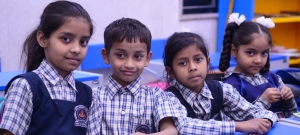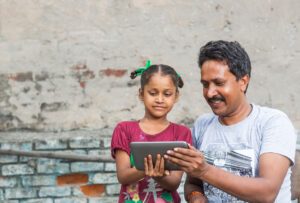Reading is an essential part of life for most of us while growing up. It was almost second nature to me and something I took for granted until I began teaching English to class 5 students in a low-income private school in Pune in 2013. I was shocked to find that despite having been in school for over 4 years, nearly one quarter of the students still could not identify letters of the alphabet and basic sounds. In spite of efforts to provide them with appropriate instruction and exposure to books, these students continued to struggle. This is the reality in many classrooms across India today, making it pertinent to understand how we as part of the education system can teach children to learn to read.
‘The Reading War’
A debate about the ‘best way’ to teach reading has been brewing among researchers and experts in the education sector for many years.
One line of thinking is that learning to read is as instinctive as learning to speak. The ‘whole language’ approach started as a grassroots movement, most likely by teachers who saw it as an alternative to the repetitive drills of the classroom, and by theorists like Ken and Yetta Goodman. Their belief is that children can learn to read by getting sufficient exposure to books and a print-rich environment. The emphasis is on providing attention to the meaning of the text and improving overall attitude towards reading, which is the ultimate goal of learning to read.
The alternate perspective is espoused by education specialist Helen Abadzi in her book Efficient Learning for the Poor, where she says that, though appealing and inherently sensible, the whole language approach puts low-income children at risk for failure. Closer home, experts like Dr Dhir Jhingran and programs such as Room to Read advocate that children who come from low literacy backgrounds and lack relevant preschool experience need explicit instruction to learn to read, along with meaning-based instruction. By understanding and applying the science of reading, we can ensure all children in the classroom are able to acquire this essential skill.
The Science of Reading
Children who read slowly or take many pauses while reading words and sentences, end up reading less and lose track of the meaning of the text. They often have to re-read the text to understand it. Why does this happen? This is because their working memory is occupied in word recognition instead of paying attention to the meaning of the text, making it an ineffective way to read.
Research in cognitive neuroscience says that to be able to read with comprehension, or simply put, to be able to understand the meaning of a sentence, it is important for our brains to have free working or short-term memory. The working memory for comprehension is available when one is able to read accurately and automatically. Speed and accuracy are, therefore, gateway skills to build comprehension abilities in children, followed by vocabulary and reading strategies such as inferences and self-monitoring.
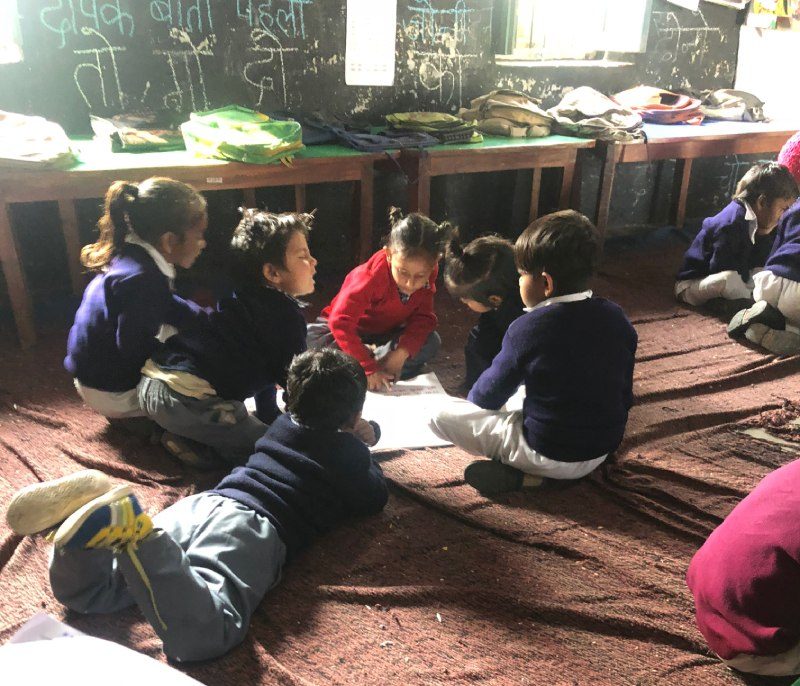
The ‘Balanced’ Approach
Experts in the field and leading research institutes like RTI International, UNICEF and CARE India recommend a ‘balanced’ approach to literacy. This involves explicit support on skills like spelling, pronunciation and word recognition to build accuracy and correctness in what one reads. It also simultaneously focuses on comprehension-related work and helping children understand the real meaning of the text they engage with.
The balanced approach is also different from the traditional approach in that it tries to move children quickly from reading letters of the alphabet to reading familiar words. For example, instead of starting the Hindi varnamala from अ, आ, इ, ई, this approach focuses on letters like न, र, ल, क, which enables children to begin making words like नल, कर and कल almost from the beginning.
Combined together, the skills required for early grade literacy under the balanced approach include:
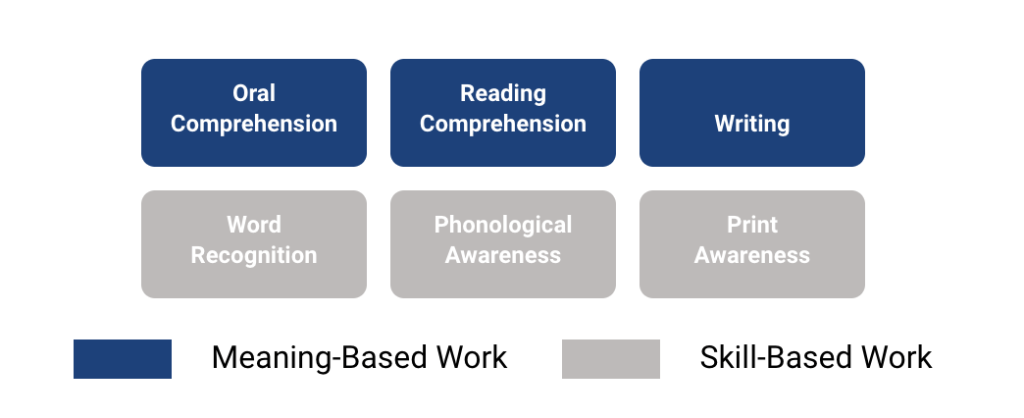
Let us look at each of these components more closely to understand what the balanced approach means in a classroom setting.

Print Awareness
This refers to the awareness of forms and functions of print and conventions of writing. Understanding how a book functions is not intuitive and therefore concepts of print must be taught as a precursor to reading. Print awareness builds a positive attitude towards reading among children and provides motivation to read.
IN THE CLASSROOM
Print awareness is taught by conducting regular reading lessons and by making the classroom print rich with charts, posters and word walls. To build print awareness in children, the teacher may conduct some of the following activities:
- explain that writing in Hindi is from left to right
- enhance knowledge around a word being preceded and followed by space


Oral Comprehension
This means providing opportunities to children to express their thoughts in the classroom. Oral comprehension helps children make connections between home and school and build an understanding of the structural aspects of a language (CARE India). It also helps in developing vocabulary, background knowledge and reasoning skills.
IN THE CLASSROOM
Oral comprehension is taught mostly through picture charts, poem posters and story books. To practice oral comprehension in the class, the teacher can:
- discuss events with children that closely connect with their daily lives or conduct role plays on the same, for example, a conversation between their family members, reasons for missing school, visit to a mela, etc.
- read a story/poem or show a picture to the children and ask them related questions about what they see in the picture/story/poem such as ‘why do you think something is happening’ and ‘if you were there, what would you have done?’, etc.
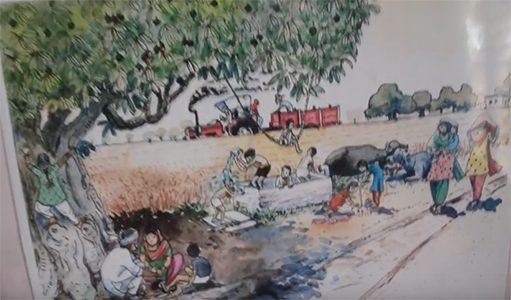
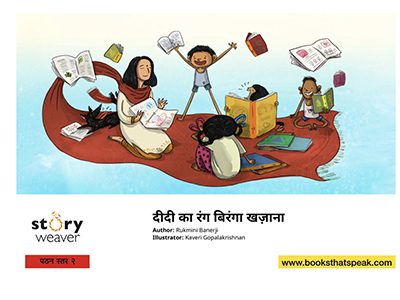

Phonological Awareness
In this step reading is the process of identifying the sounds of a language. Children should be able to identify sounds in words before they begin to associate symbols and words.
IN THE CLASSROOM
Phonological awareness is a foundational skill to learning to decode. For example, to teach the sound of the letter M, the teacher can:
- give examples of words with the sound of /m/, like mat, more, mop, man, etc.
- ask children to raise their hand when they hear the sound of /m/
- encourage children to give examples of words starting with /m/
Given below is an example of an activity conducted for phonological awareness, called Scavenger Hunt:


Word Recognition or Decoding
This is the process of reading a word by sounding out each symbol and joining sounds to form a word. Improved decoding helps with comprehension as it frees the child’s working memory to pay attention to comprehension of what is being read.
IN THE CLASSROOM
It is usually taught with the help of decodables, which are texts written using words that utilize sounds students have been taught. Here is an example of a decodable:
For example, to read the word ‘गमला’, children are taught three things under decoding:
- recognition of individual sounds in the word, i.e., /ग/, /म/ and /ला/ in this case
- association of sounds to the symbols that they represent, i.e., ग, म and ला
- putting the sounds together in the correct order and reading them together
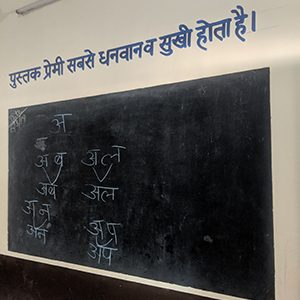

Reading Comprehension
Reading is the process by which children derive meaning from the text. There are three levels of comprehension:
- Literal: where thinking on questions like ‘what is the colour of the ball?’ is developed
- Inferential: where thinking on questions like ‘why is the boy happy?’ is developed
- Making Connections: where children learn to make connections with the text, e.g., ‘if a thief entered your house, what would you do?’
Comprehension should be the focus of all reading activities in the classroom as it is the final outcome of learning to read.
IN THE CLASSROOM
Reading can be taught through the following ways:
- teachers reading a story to children and following it with discussion across different levels of comprehension
- children reading stories with the help of the teacher, followed by discussion on the story
- independent reading by the children
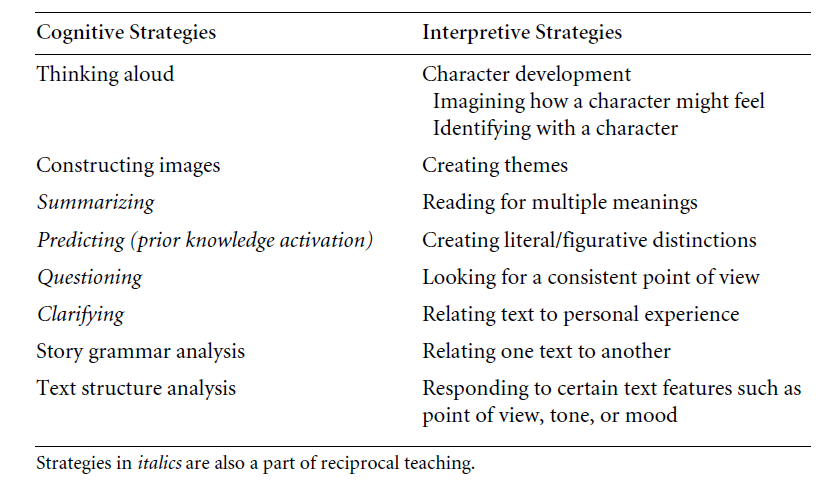
(Source: What Research Has to Say About Reading Instruction, Third Edition – © 2002)

Writing
Writing is a medium of communication that represents language and emotion with signs and symbols. Early acts of writing reinforce the knowledge of letters and words and lead to better comprehension.
IN THE CLASSROOM
Among children, writing begins in the form of invented writing or drawings/ scribblings. Eventually, it can take the following forms:
- children explaining an incident and teachers writing it on the board, followed by children reading the words written on the board with the teacher
- children writing letters, words and short sentences in a structured form

(Image: What We Have Learned in the Past Decade: RTI’s Approach to Early Grade Literacy Instruction)
The balanced approach to literacy can seem daunting at first, but various organizations have found ways to implement it on the ground in varying conditions across India. Teachers in schools where this approach has been adopted, have reported that it positively influences classroom processes and student learning. Children learn to read faster, retain content better, and seem to enjoy and actively participate more in the classroom as a result. In fact, based on such experiences and our learnings from research and experts, we at Central Square Foundation are working to take this approach to Gujarat in our attempt at demonstrating effective classroom solutions to improve learning outcomes at reasonable scale. Eventually, the goal is to ensure that all children, regardless of their circumstances and background, learn to read in school, providing them with the foundation for lifelong learning and development.

